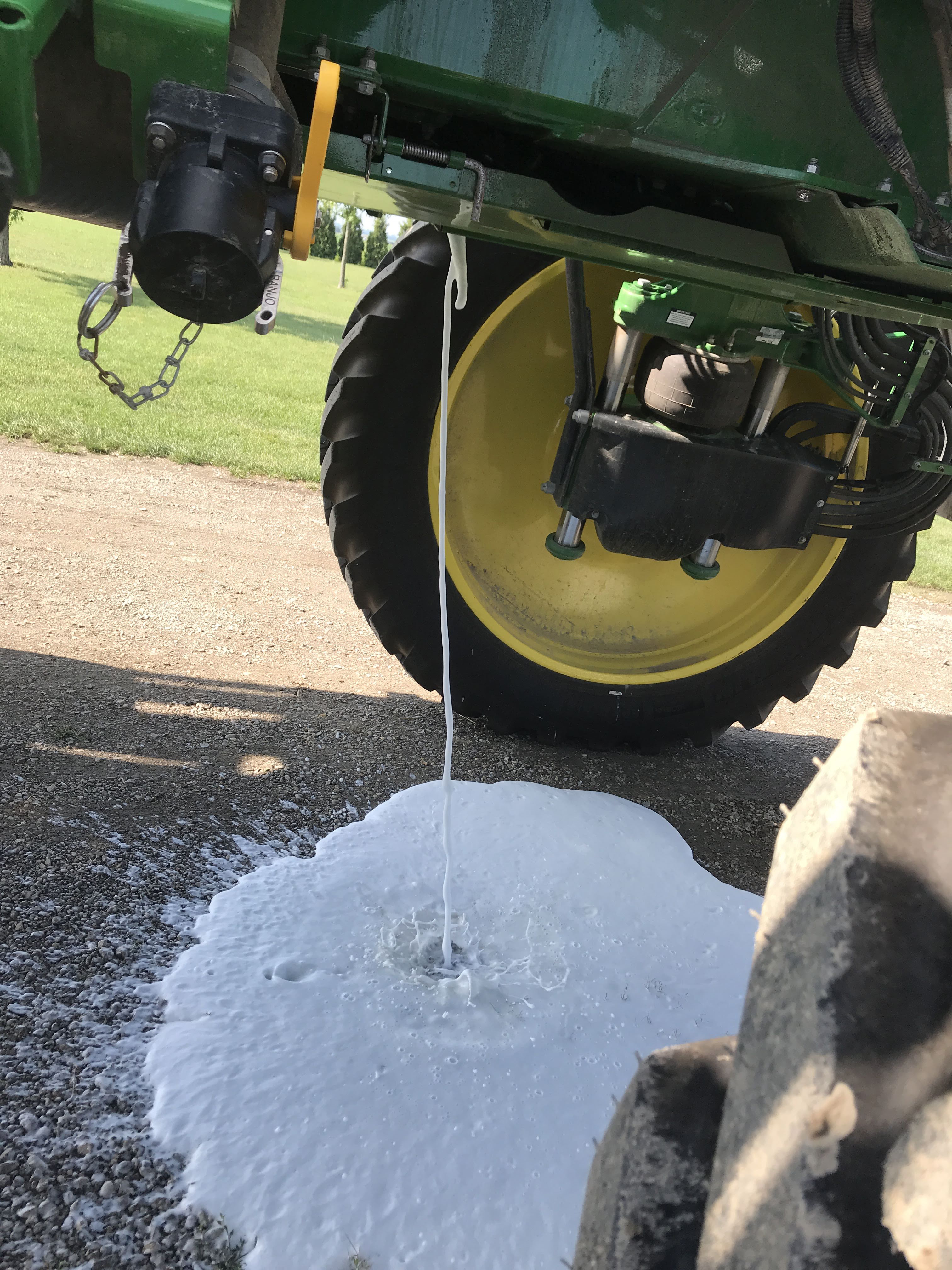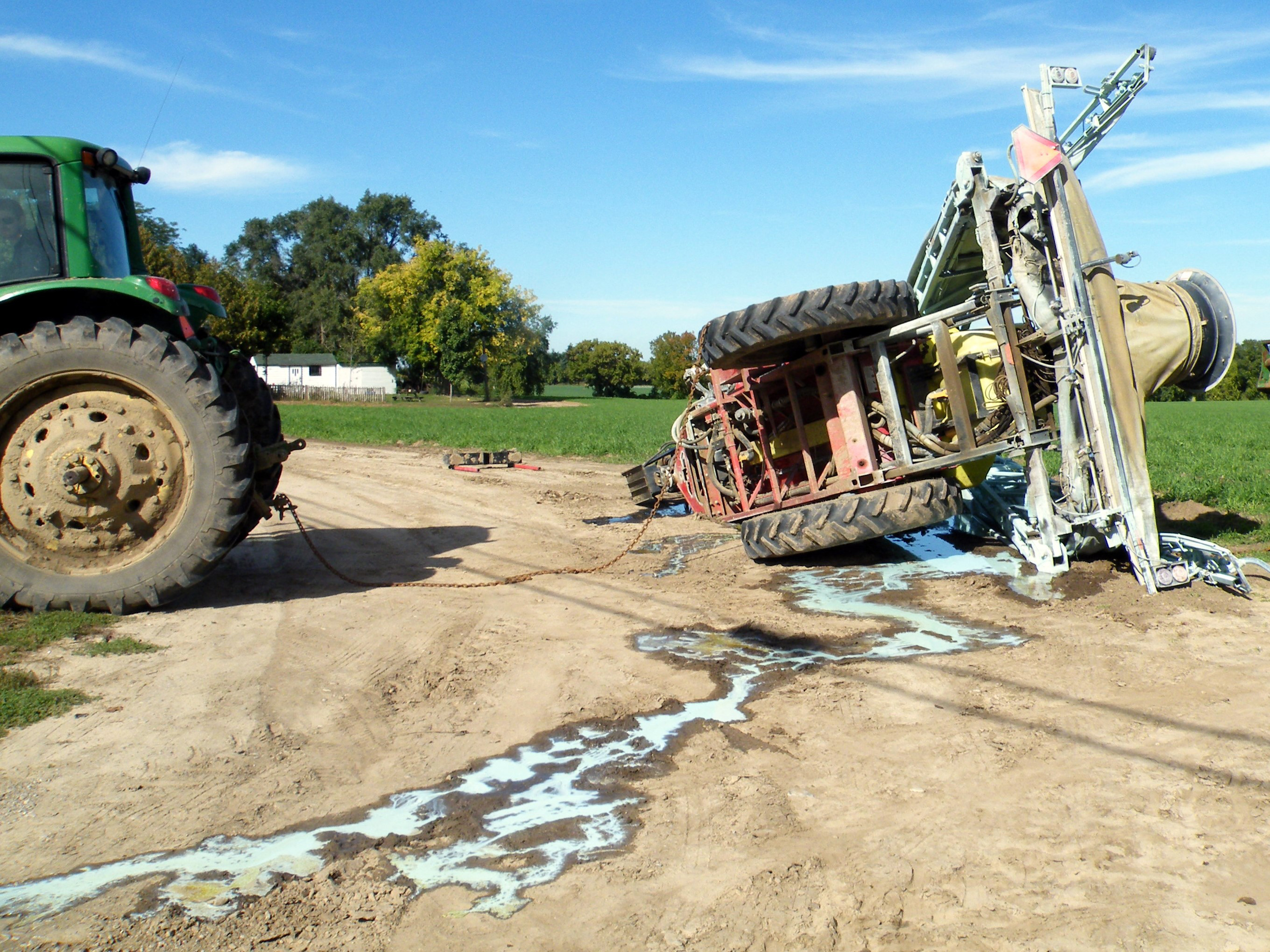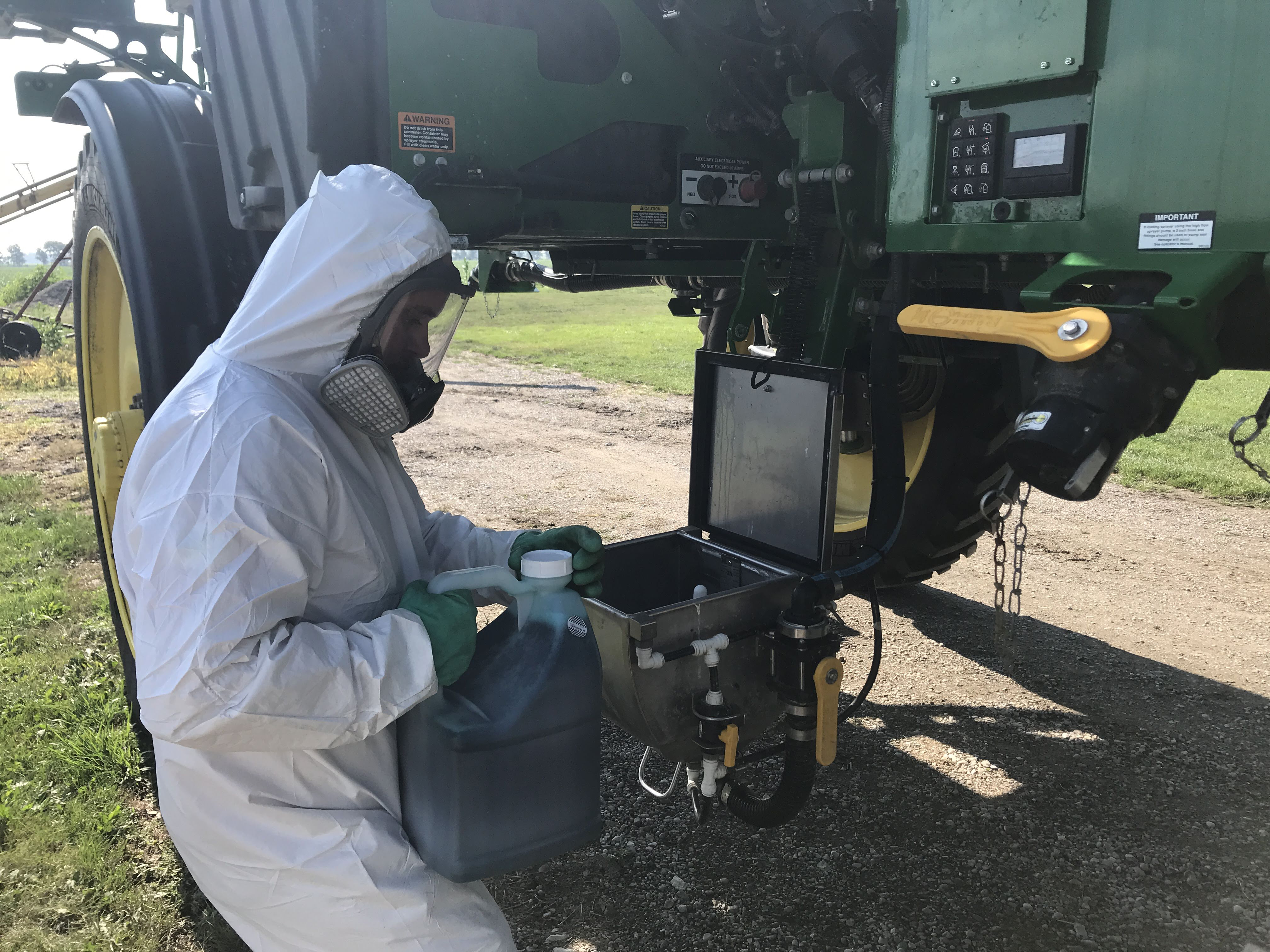Handling pesticides safely to prevent spills
Learn how to recognize safe pesticide handling procedures, prepare a spill contingency plan and understand your obligation and reporting requirements if a spill does occur. This technical information is for Ontario producers.
ISSN 1198-712X, Published October 2020
Introduction
Pesticides are used to protect crops from insects, weeds and diseases. A pesticide spill is when any amount of pesticide ends up where it does not belong (Figure 1).
Depending on the product and the location, a spill can be hazardous to the environment, and can be difficult and costly to clean.
Minor spills can occur during mixing and loading. Major spills can occur in storage, during transport, when applying products or disposing of rinsate. While accidents can happen, most spills can be prevented by following proper storage, transportation and handling practices.
Use this factsheet to:
- recognize safe pesticide handling procedures
- prepare a spill contingency plan
- understand your obligation and reporting requirements if a spill does occur

Using pesticides in Ontario
In Ontario, farmers who use Class B or C pesticides on their farms or woodlots, or on any farm they work on, must be certified.
To become certified, complete the Grower Pesticide Safety Course.
Read Ontario's Guide to Pesticide Classes for more information on pesticide classification and use restrictions.
Where to find pesticide safety information
Pesticide labels
A pesticide label is a legal document stating specific application requirements (e.g., registered crops, application rates, buffer zones, spray quality). Follow all label directions when using pesticides.
Use Health Canada’s Pest Management Regulatory Agency (“PMRA”) label search tool or PMRA’s mobile app for iPhone or Android to search for registered pesticide labels.
Material safety data sheets
A material safety data sheet (MSDS or SDS) contains information on:
- potential hazards (e.g., health, fire, reactivity, environmental)
- instructions on how to work safely with a pesticide product, including storage, transportation and required personal protective equipment (PPE)
Contact the pesticide manufacturer to obtain copies of the MSDS.
Best management practices for handling pesticides and preventing spills
Handle pesticides safely and prevent spills by following proper procedures to use, store and transport pesticides. A wealth of additional information is available in the following resources:
- Environmental Farm Plan Infosheet #3: Pesticide Handling and Storage
- Ontario Pesticide Education Program: Grower Pesticide Safety Course Manual
- OMAFRA Best Management Practices: Pesticide Storage, Handling and Application
- Sprayers101.com is a resource for safe, effective and efficient agricultural spraying
Planning
- Make a list of pesticides stored on farm. Keep copies of this list in two or more separate locations, such as the office or barn. Include copies of the pesticide labels and MSDS sheets. Review and update this list annually.
- Become familiar with all specific storage, transportation, safety and first aid requirements listed on each pesticide label and each MSDS.
- Speak to the farm insurance agent to ensure the farm is properly protected for pollution liability.
Storage
- Keep the pesticide storage area well organized.
- Allow for easy access to materials.
- Use suitable shelving, lighting and ventilation.
Transport and storage
- Secure pesticide containers when in transit.
- Modify driving style to cargo and road conditions (Figure 2).
- Follow all requirements of the Transportation of Dangerous Goods Act, 1992.

Mixing, loading and application
- Always wear appropriate personal protective equipment (PPE) to shield against pesticide contamination (Figure 3).
- Use a containment pad for mixing and loading.
- Use a secure platform to access sprayers for loading.
- Use an anti-backflow device to prevent back-siphoning into a water source when filling the sprayer.
- Do not leave the sprayer unattended when filling.
- Use proper agitation rates to ensure good mixing. Over-mixing can lead to foaming and spills (Figure 1).
- Check for leaks, sound hoses and faulty valves.
- Contain and manage any spillage.
- Maintain sprayer and keep it in good condition.

Spill contingency plan
A spill contingency plan identifies who to notify, and what procedures to follow to safely halt a spill and then clean it up.
Create a plan and include the following information:
- a step-by-step procedure in the event of a pesticide spill
- a map of the farmyard showing locations of pesticide storage, mixing and handling areas, as well as contamination risks such as wells or drains
- local emergency contact information (see the template in this factsheet)
Review the plan annually to ensure it is up to date. Keep a copy on file and post copies in a visible place near the pesticide storage, loading area and at the farmhouse. Store spill clean-up equipment nearby.
Spill kit
Create and maintain a “spill kit” with materials to contain and clean up any spills.
Purchase a pre‑made kit or collect materials to create one. Keep a spill kit in the pesticide storage area, in the sprayer and anywhere else pesticides are used or stored.
Recommended contents of a spill kit:
- chemical-resistant gloves, coveralls, boots and goggles
- respirator
- absorbent materials suitable for pesticides (e.g., pads, granular material, containment “snake”)
- bentonite/polymer mixture for plugging leaking containers
- shovel, broom and dust pan
- temporary hazardous material storage bag
- warning sign
Larger kits may include a pop-up containment pool and/or weatherproof, incinerable drum rated for hazardous materials.
Steps to clean up a pesticide spill
If a pesticide spill occurs, assess the situation immediately.
The owner of the pesticide, or the person who had control of it immediately before the spill, is responsible for the spill even if he/she is not at fault.
- Wear personal protective equipment (PPE) to protect against pesticide contamination.
- Control the spill by stopping the source, if possible.
- Isolate the spill area and keep people and animals away.
- Contain the spread of the pesticide to prevent further contamination of the environment.
- Remove contaminated clothing. Wash skin thoroughly with soap and water. Read the product label for treatment information. Get medical attention.
- Immediately contact the local Ministry of Environment, Conservation and Parks (MECP) office or the 24-hr Spills Action Centre at
1-800-268-6060 . - Clean up the spill as advised by MECP or the Spills Action Centre.
- Decontaminate the areas as advised by MECP, the Spills Action Centre, and as listed on the MSDS. Decontaminate all equipment used in the clean-up, using the same procedure.
- Dispose of contaminated material as designated by MECP.
- Document the spill and keep records of what happened. Re-evaluate the spill contingency plan. Restock the spill kit.
Spills action centre
When reporting a spill, the following questions may be asked by the Spills Action Centre or your local MECP office:
- Date, time and location of the spill
- How long did the spill last and whether the spill is still ongoing?
- What material was spilled?
- How much was spilled?
- What was the source of the spill? (e.g., tanker truck, sprayer, product container)
- What was the concentration of the spilled material?
- Is the spill contained?
- Has the spill entered any watercourses?
What you will learn from the Spills Action Centre:
- recommended ways to clean up the spill
- decontamination procedures
- proper disposal of the contaminated material(s)
Emergency phone numbers
Use this list to record local emergency phone numbers. Post a copy of this list outside the pesticide storage area, in the sprayer and anywhere else pesticides are used or stored.
Farm location/address:
Location of spill contingency plan:
Locations of pesticide spill kits:
Family Doctor:
Ministry of the Environment, Conservation and Parks (MECP):
Spills Action Centre:
Ontario Poison Centre:
Ambulance: 9-1-1 or:
Fire department: 9-1-1 or:
Police: 9-1-1 or:
Hospital:
Municipality:
Insurance agent:
Electrical utility:
Gas/oil company:
Summary
A pesticide spill that causes, or is likely to cause, an adverse effect greater than that which would result from the proper use of the pesticide must be reported to the MECP Spills Action Centre and the local municipality.
Always follow all legal requirements when using pesticides and consult a lawyer for clarity on specific legal obligations. Follow safe pesticide handling procedures to prevent spills, protect the environment and keep yourself safe.
This factsheet was revised by James Dyck, P.Eng., engineering specialist, Crop Systems & Environment, OMAFRA and reviewed by Jason Deveau, PhD, application technology Specialist, OMAFRA.